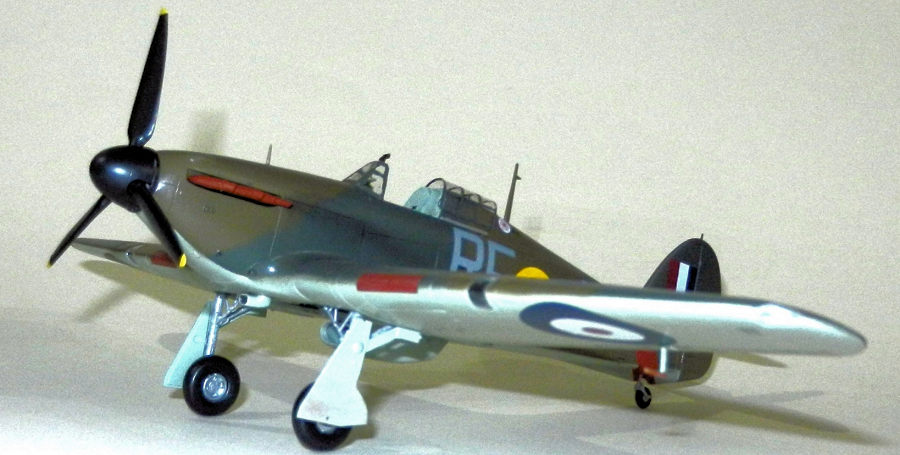
| KIT #: | 09470 |
| PRICE: | CAD$40.00 |
| DECALS: | Two options |
| REVIEWER: | Pablo Calcaterra |
| NOTES: | Airwaves PE seat belts, vac formed canopy, Techmod 48046 |

| HISTORY |
John Alexander Kent was born in Winnipeg in 1914. Since he was a kid he was attracted to planes. With his father support he started to take flying lessons and became the youngest Canadian pilot at age 17. A couple of years later and after amassing more hours working at the Aero Club and the Aero Marine Company he also became the youngest Commercial Pilot in Canada. During this time he met many famous Canadian aces like Roy Brown and Billy Bishop along others like Ernie McNab who would later lead 1 Sqn RCAF during the Battle of Britain. Along with some friends they built some small planes (that we would call ultra lights) having some close shaves…but always walking away without a scratch.
He was accepted in the RAF for a Short Service Commission in 1935 and after training he egressed as #1 in flying and #5 in theorical. Johnny flew several types of aircraft (including Harts) till he was accepted as a test pilot in Farnborough. For his work to test wire cutter on the wings of airplanes he was presented the AFC by the King.
Shortly before the start of the war Kent became a member of the PDU flying specially modified Spitfires and Hudsons. The first were painted in bright blue, had no armour windshield or armament and the canopy had blisters that streamlined the internally attached rear mirrors.
When war broke, he flew several missions on these
specials Spitfires. Some from their base in the UK and then from France during
the later phases of the Battle of France. During one of these and now on an
armed Recco Spit he participated on air combat between 4 Hurricanes and 12
Me109. He latched to one of the later and had to pull up desperately when he
realized that the German’s dive was leading them too close to the ground. On
looking back he saw fire and black smoke with a crater where he believes the
German crashed. This kill has not been credited. Returning to England he was
given command of a flight in 303 Sqn flown by the Poles. At the beginning he was
not happy due to the language barriers but after they showed their
aggressiveness (that he had to match) he fully embraced the task ahead. Kent
became such an important part of 303 that he was then nicknamed Kent-owski by
his fellow pilots. On August 31st
303 Sqn was d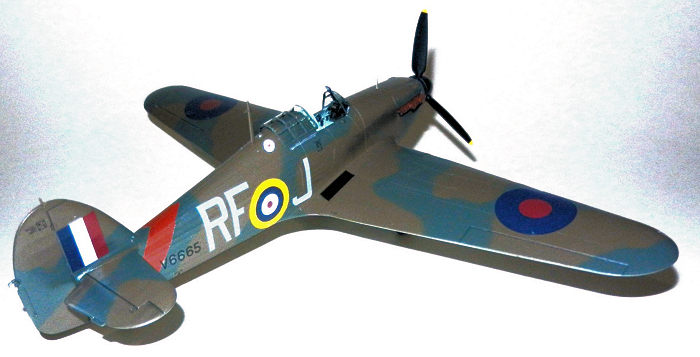 eclared operational. On occasion Kent would lead the three
squadrons based in RAF Northolt into battle (1 Sqn RAF, 1 Sqn RCAF and 303 Sqn).
After 6 intense weeks during the Battle of Britain (to a point that at the end
of one day there were only 2 Hurricanes in flying condition out of the 18 they
had started with that particular day) 303 was rested and Kent was given command
of 92 Sqn who had suffered the loss of 4 Squadron leaders in a few months with
some of them not lasting more than 2 days. Their moral was very low.
eclared operational. On occasion Kent would lead the three
squadrons based in RAF Northolt into battle (1 Sqn RAF, 1 Sqn RCAF and 303 Sqn).
After 6 intense weeks during the Battle of Britain (to a point that at the end
of one day there were only 2 Hurricanes in flying condition out of the 18 they
had started with that particular day) 303 was rested and Kent was given command
of 92 Sqn who had suffered the loss of 4 Squadron leaders in a few months with
some of them not lasting more than 2 days. Their moral was very low.
During the 6 months in command of 92 Squadron he shaped them up into a proud and efficient combat unit. This squadron was the first one to efficiently use the 20 mm cannon and from that point onwards there was no more discussion between those claiming more .303s and those who wanted cannons. After a brief spell at an OTU Ken was given command of the Polish Wing. His personal Spitfire was adorned with a Maple Leaf inside of which there was the distinctive of the Polish Air Force.
After months of operations Johnny was sent to rest to an OTU again and from there to give lectures to Canada. He met his family for the first time in almost 10 years. When he returned to the UK he was posted to 17 Group in Cairo to replace the Argentine Dudley Honor who showed him around during the first days after his arrival. Kent even inherited Honor’s cannon armed scruffy Hurricane (DS-H). During a test flight Kent was vectored to a bogey that turned out to be a Ju88. He damaged one engine but then his guns stopped. Fuming he returned to base to find out that the shells in his plane had been sitting in boxed under the sun and were full of sand and rust. His complaints meant that the existence of the “unofficial” Hurricane was discovered by the higher ups and removed from his command…
He was in charge of several
key bases and also put in charge of the logistics for the air support to the
failed British attack in the Dodecanese. After this he was sent to Training
Command for a year. He tried to escape from this without luck as many other aces
tried. Basil Embry tried to help Johnny to get back into combat but the war in
Europe ended before they succeeded. He became a Chief Test Pilot in the RAF and
flew several prototypes and early jets. Indeed he was qualified to land in plane
carriers (HMS Warrior) as part of his training to participate in the project to
land Vampires on an inflatable landing strip being one of the 3 test pilots (one
other was the famous Lt. Cdr. Eric Brown. He did a tour in the USAF which taught
him lots of new things. He was in charge of RAF Tangmere and then put in charge
of the Admin of Group 12. Several d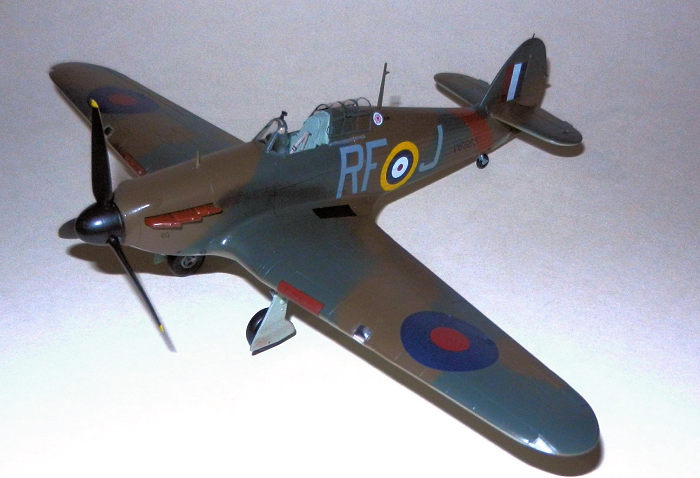 isappointments with the post war RAF
behaviors led him to retirement in December 1956. He worked for a few years as a
sales man in an aviation company and like other veterans had failures doing
business in civvy street.
isappointments with the post war RAF
behaviors led him to retirement in December 1956. He worked for a few years as a
sales man in an aviation company and like other veterans had failures doing
business in civvy street.
Regretfully like many others the war had caused emotional hurting to Johnny (what we now call PTSD and that affected many famous pilots like Jack Charles, Ken Charney) and he developed a drinking problem. His marriage broke with his wife leaving him. He was a humble man was mostly shunned away by others. His kids rarely saw him. He was even dismissed by some former RAF BoB heroes because his upbringing was from a humble family in Canada…to a point that once he tried to introduce a journalist to a BoB famous ace at the RAF Club and when the ace saw that it was Kent who was tapping him to get his attention, he just gave him his back.
His memories were published in 1971 and sometime in the ‘70s he developed Parkinson’s. Johnny Kent passed away in 1985 with only 71 years of age. His ashes were spread over RAF Northolt. Group Captain John Alexander Kent DFC and Bar, AFC finished the war with 13 confirmed, 3 probable and 3 damaged.
His book’s latest edition with a Prologue and Epilogue by his daughter is highly recommended to understand the sacrifices done by the pilots and their families. Out of the 64 portraits by Capt Orde the only one where a pilot has not only the RAF wings but a different air force ones is Kent: he proudly showed his Polish Air Force wings above the RAF ones.
| THE KIT/ CONSTRUCTION |
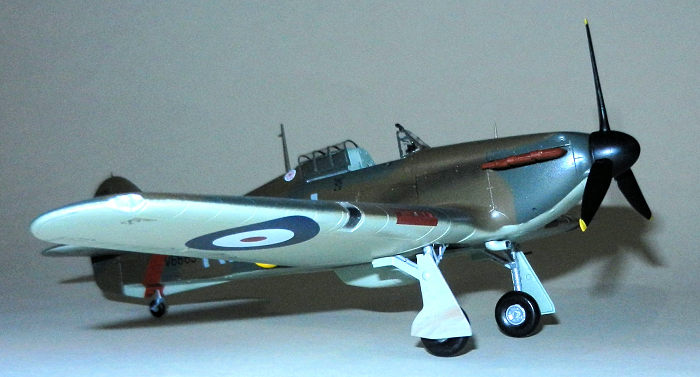 This
version of the classic Hasegawa Hurricane was released in 2003 and has decals to
make RSTuck’s famous Hurricane during the winter of 1940/41 among a couple of
versions more. This kit has been reviewed many times in M2 so I won’t bother you
with something you already know.
This
version of the classic Hasegawa Hurricane was released in 2003 and has decals to
make RSTuck’s famous Hurricane during the winter of 1940/41 among a couple of
versions more. This kit has been reviewed many times in M2 so I won’t bother you
with something you already know.
To the very complete cockpit I added some PE seat belts from Airwaves painted in light beige. There was very little if nothing at all putty to be used in the construction of the fuselage.
The bottom side of the wings was attached and before the glue had dried the top halves were added. The inserts for the machine guns (and those for the extra machine guns for the wings) required a bit of sanding and putty to achieve a better surface.
There was no problem with the horizontal tail planes. Main landing gear legs were attached and the tail wheel was glued in place. Very fast and easily I was ready to start painting the Hurricane.
| COLORS & MARKINGS |
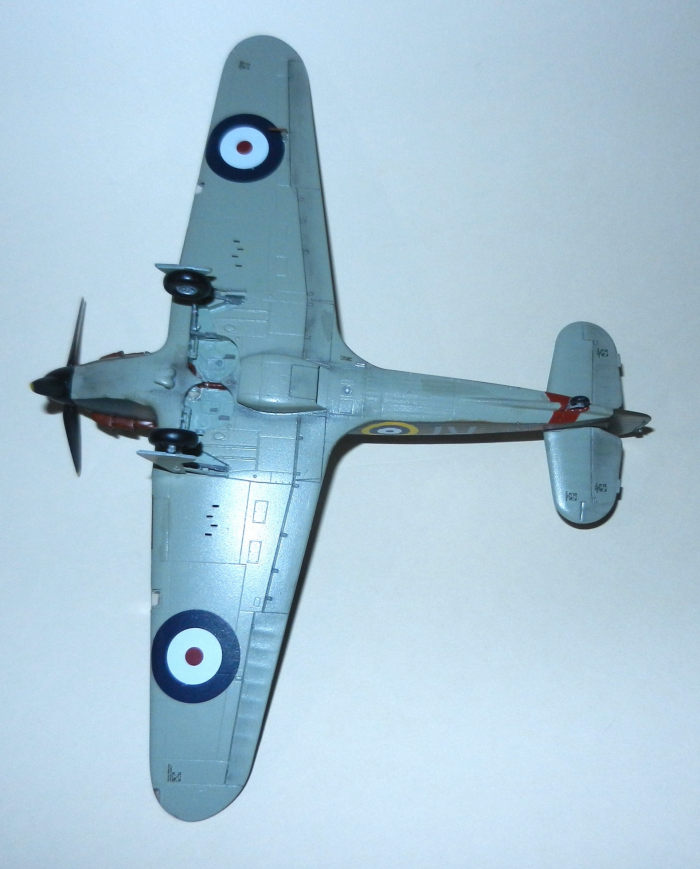 Canopy and windshield were given a coat of Vallejo black primer. Then everything
received a coat of Vallejo light grey primer. I masked the band on the fuselage.
Undersides were painted RAF Sky using Model Master Acrylics. Then with this
masked as well the top was painted with RAF Dark Brown and then RAF dark Green
(from MM Acrylics).
Canopy and windshield were given a coat of Vallejo black primer. Then everything
received a coat of Vallejo light grey primer. I masked the band on the fuselage.
Undersides were painted RAF Sky using Model Master Acrylics. Then with this
masked as well the top was painted with RAF Dark Brown and then RAF dark Green
(from MM Acrylics).
Propeller and wheels followed in black. I removed the mask for the fuselage band, masked the edges (covering the cammo colours) and the exposed light grey primer was sprayed with red. Sanded black pastel applied with a Q tip dirtied the kit especially around the moveable surface areas and undersides. A thin black pencil highlighted rudder, elevators, flaps and ailerons. A bit of aluminum highlighted the runner for the canopy.
For this I used a combination of the kit’s (stencils, national insignias) and Techmod’s. They all reacted very well to Set and Sol. V6665 was a plane sent to 303 Sqn to replace the losses on September 5th. The red ID band apparently was painted to identify the plane of a Flight Commander. On the 9th Kent claimed his first two victories (a probable Ju88 and a confirmed Me110) on this plane. On September 27th V6665 was shot down and his Polish pilot killed.
Navigation lights were painted using silver and then clear red and green and then the clear parts attached. The one on the tail was just painted white.
Wheels and landing gear doors were attached, followed by the pitot. Windshield was glued in place after installing the gunsight. The canopy received 4 handles made with a black bristle cut to size and bent to shape. I attached the exhausts (rust with some drybrushing with bronze). I finally added the antenna mast, the propeller blades and spinner and with this the kit was finished.
| CONCLUSIONS |
A very good kit, typical Hasegawa quality (though I did not fix the too sharp transition on the back spine after the cockpit)
To prove my admiration for Johnny Kent…his Orde’s drawing is one of the scrolling faces that I have on my Fitbit watch…
| REFERENCES |
Hurricane Aces 1939-1940 (Tony Holmes - Osprey)
One of the Few (J. Kent and Alexandra Kent)
Wikipedia
https://acesofww2.com/can/aces/kent.htm
Pablo Calcaterra
19 September 2023 Copyright ModelingMadness.com. All rights reserved. No
reproduction in part or in whole without express permission from the editor. If you would like your product reviewed fairly and fairly quickly, please
contact
the editor
or see other details in the
Note to
Contributors.